Efficient and Environmentally Friendly Cooling for Professional Use: REXNORDIC cooler
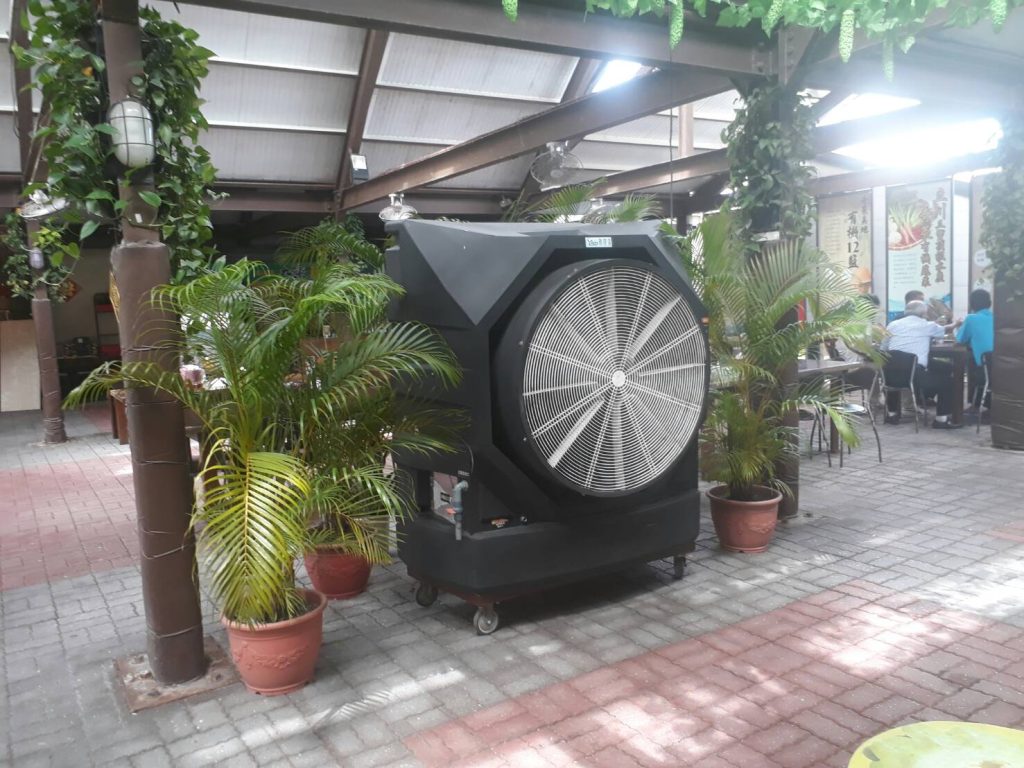
REXNORDIC evaporative coolers are excellent choices for professional use due to their efficiency, environmental friendliness, and low operating costs. This article discusses why an evaporative cooler is a good choice for professional use and where it can be used. Operating Principle of Evaporative Coolers Evaporative coolers operate on a simple yet effective principle: they use water evaporation to cool the air. As air passes through a wet filter, the water evaporates and absorbs heat from the air, lowering the air temperature. This process is highly energy-efficient as it consumes significantly less electricity than traditional air conditioning units. Benefits in Professional Use Energy Efficiency and Cost Savings: The Rex Nordic Ecocooler is a highly energy-efficient cooler. In professional environments where cooling is continuous, the energy savings can be significant, reducing overall costs. Environmental Friendliness: Unlike traditional air conditioners, evaporative coolers do not use environmentally harmful refrigerants. This makes them an ecologically sustainable option that reduces the carbon footprint. Ease of Use and Low Maintenance: The Rex Nordic Ecocooler is designed to be user-friendly and requires minimal maintenance. The device only needs regular cleaning and water refills, reducing downtime and maintenance costs. Improves Working Conditions: Evaporative coolers not only cool the air but also improve air quality by adding humidity. This is particularly beneficial in dry and dusty environments such as warehouses and industrial halls, where employee comfort and health can be significantly improved. Additionally, the Rex Nordic Ecocooler is equipped with built-in UV light that destroys all bacteria and viruses. Applications The Rex Nordic Ecocooler is suitable for various professional environments: Industrial Halls and Warehouses: Large and open spaces like industrial halls and warehouses benefit significantly from evaporative cooling. The Ecocooler can efficiently cool large areas, improving working conditions and increasing productivity. Construction Sites: On construction sites, working conditions can be challenging due to high temperatures and dust. An evaporative cooler can help keep the working area cooler and less dusty, enhancing worker comfort and safety. Agriculture and Greenhouses: Greenhouses and farms benefit from evaporative cooling as it helps maintain optimal temperature and humidity levels for the well-being of plants and animals. Events and Outdoor Spaces: At outdoor events such as festivals or sports events, evaporative coolers can provide comfort to large crowds. The Rex Nordic Ecocooler is portable and easy to install, making it an ideal solution for temporary cooling. Summary The Rex Nordic Ecocooler is an excellent choice for professional use due to its energy efficiency, environmental friendliness, ease of use, and versatile applications. Whether it’s an industrial hall, construction site, farm, or outdoor event, the Rex Nordic Ecocooler offers a reliable and cost-effective cooling solution that improves working conditions and reduces operating costs.
How Professional Evaporative Coolers Work?
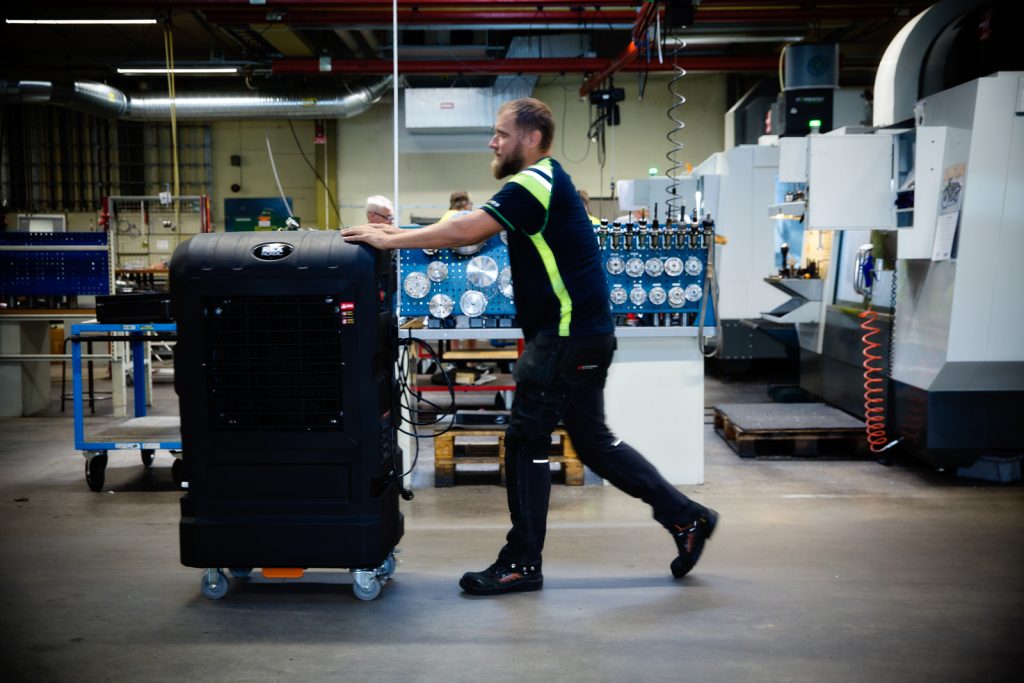
Evaporative coolers are an essential part of modern cooling technology, especially in industrial and other large-space cooling applications. Their advantages include energy efficiency and environmental friendliness compared to traditional air conditioning systems. This article examines the operating principle, applications, and benefits of evaporative coolers, as well as the technical aspects to consider when using them. Operating Principle of Evaporative Coolers Evaporative coolers utilize the evaporation process of water to cool the air effectively. This is based on a physical phenomenon where water evaporates and absorbs heat energy from the surrounding air, leading to a decrease in air temperature. Humidification and Heat Transfer Water evaporates when exposed to an airstream, and this process absorbs heat from the air, cooling it down. Coolers use special pads designed to maximize the surface area for water evaporation. These pads are often made of cellulose or plastic, which are hygroscopic and provide a large evaporative surface. Air flows through the pads via a fan, where it encounters water. The water evaporates, absorbing heat energy from the air, thus cooling it. Energy Consumption and Efficiency The energy consumption of evaporative coolers is significantly lower compared to traditional mechanical cooling systems because the process uses natural water evaporation and does not require substantial amounts of electrical energy. The efficiency of these systems depends on the ambient temperature and humidity. They work best in dry and hot conditions where the air’s moisture content is low, as this makes water evaporation most efficient. Operational Principle Adiabatic Cooling: Air is cooled through an adiabatic process where its temperature drops as it becomes humidified. This means that the air’s thermal energy is used for water evaporation without an external energy source. Ventilation and Pressure: In the cooler, air passes through the pads via a fan. The air flowing through the pads encounters moisture that evaporates and cools the air. The fan’s role is critical as it ensures sufficient airflow through the pads and guarantees uniform cooling. Water Circulation: In evaporative coolers, water circulates continuously. Water is pumped to the top of the pads, from where it flows down and evaporates due to the airstream. The recirculation system ensures even water distribution and optimizes the cooling process. Applications in Professional Use Evaporative coolers are widely used across various industries and other large-space cooling applications where efficient and cost-effective cooling is needed. Industrial Facilities Metal Industry: In hot factory halls where temperatures can rise extremely high, evaporative coolers provide an efficient cooling solution that helps keep the working environment tolerable and safe. Automotive Industry: Assembly lines and paint shops in car factories benefit from a cooler working environment, which improves worker efficiency and reduces errors. Food Industry: Evaporative coolers are ideal for cooling large storage and production areas where temperature control is critical to maintaining product quality. Data Centers Data centers require continuous and efficient cooling to prevent equipment from overheating. Evaporative coolers offer an energy-efficient alternative that can significantly reduce cooling costs in data centers. Using adiabatic cooling, data centers can also reduce their carbon footprint, which is increasingly important as environmental regulations tighten. Agriculture Greenhouses: Evaporative coolers help maintain optimal growing conditions, improving crop yields and growth rates. Cooler air reduces plant stress and enhances their resistance to diseases. Animal Shelters: Animal welfare improves in cooler conditions, leading to better health and productivity. This is especially important during the summer months when heat stress can negatively affect animal well-being. Advantages and Challenges Evaporative coolers offer many advantages. Advantages Energy Efficiency: Evaporative coolers use significantly less electrical energy compared to traditional cooling systems because they rely on the natural evaporation process. Environmental Friendliness: Since the system only uses water and air for cooling, its environmental impact is minimal, and the carbon footprint is small. This makes them an attractive option for organizations aiming to reduce their environmental impact. Cost Savings: Lower energy consumption and simple technology mean lower operating and maintenance costs compared to complex mechanical cooling systems. Technical Considerations and Design Portable evaporative coolers are highly convenient and flexible solutions for various professional cooling needs. Their technical design and use require special attention to the following aspects: Components and Materials Pads: The pads are the central part of the cooler responsible for water evaporation. They are often made of cellulose or plastic, providing a large evaporative surface and withstanding moisture and mechanical wear. Fans: Powerful fans ensure sufficient airflow through the pads. The performance of the fans directly affects the efficiency of the cooler. Water Systems: Water systems pump water to the top of the pads, from where it flows down and evaporates due to the airstream. The systems include filters and pumps that ensure water circulation and cleanliness. Device Placement Airflow Control: Optimal airflow and ventilation are essential to maximize cooling. Portable coolers should be placed to draw in as much dry and hot air as possible for the most effective evaporation. Water Source and Quality: A clean and adequate water source is vital for the system’s operation and longevity. Water quality affects the durability and efficiency of the pads and water systems. Considering Portability Durable Construction: Portable evaporative coolers must be durable and sturdy enough to be easily moved to different locations. This means strong frame materials and well-protected components. Practical Wheels: Large wheels enable easy movement of the device and are designed to withstand various floor materials and surfaces. Easy Connectivity: Coolers are easy to connect to electrical and water sources in different locations. They have practical connections and sufficiently long cables and hoses. Impact of UV Light UV light is used in evaporative coolers to improve water quality and prevent bacterial growth. Water Disinfection: UV light kills microorganisms and bacteria in the water, reducing biofilm and slime formation on the pads. This improves the system’s hygiene and reduces maintenance needs. Pad Cleanliness: UV light helps keep the pads free from biological impurities, enhancing their evaporative efficiency and extending their lifespan. Cost Savings: Using UV light reduces the need for chemical cleaning agents and improves the system’s
Why Choose the Rex Nordic HP19 Portable Heat Pump Over a Traditional Heat Pump?

The Rex Nordic HP19 heat pump is an innovative solution that combines portability, efficiency, and ease of use. This heat pump offers unique advantages compared to traditional heat pumps, especially for professional use. Here’s why the Rex Nordic HP19 is an excellent choice for various situations and needs. Portability The Rex Nordic HP19 is designed to be easily portable, meaning you can take it with you as needed. This is especially useful on construction sites where heating or cooling is required in different places at different times. Its portability also makes it an excellent option for events, temporary workspaces, or other short-term needs. This feature allows you to use the device exactly where it’s needed most without the need to purchase multiple fixed units. No Fixed Installation Unlike traditional heat pumps, the Rex Nordic HP19 does not require fixed installation. This means the device can be put into use without major renovations or modifications, saving time and money. It also makes the device more flexible and easier to use in various spaces, such as rented premises or temporary buildings where fixed installations are not possible or desirable. No Electrician Needed Since the Rex Nordic HP19 does not require fixed installation, its setup does not require the assistance of an electrician. This makes the device even easier and faster to use, reducing installation costs. Its simple plug-and-play setup allows anyone to use it without special expertise. Durable Construction The Rex Nordic HP19 is built for heavy professional use. The device is made of steel, not plastic, ensuring its durability even in demanding conditions. This makes it a reliable and long-lasting option. The metal construction withstands impacts and wear well, which is important in industrial environments or construction sites where equipment can face harsh conditions. Components Suitable for Conditions The components of the device have been carefully selected to ensure they suit demanding conditions. This ensures efficient operation and longevity even when exposed to harsh operating conditions. The durability and reliability of the components are particularly important when the device is used in environments where conditions can vary significantly throughout the day. Professional-Grade Air Filters The Rex Nordic HP19 is equipped with professional-grade air filters suitable for dirty environments. Metal mesh filters are washable, making them easy to maintain and extending their lifespan. Additionally, the filters are easily accessible, making their maintenance and replacement straightforward. This is especially useful in places where air filters tend to get dirty, such as industrial plants or construction sites. Effective HEPA Filtration The device also offers an optional highly effective HEPA filtration. This ensures that air quality remains excellent, which is particularly important in production lines and other processes where clean air is essential. HEPA filtration removes fine particles, allergens, and other impurities from the air, improving working conditions and reducing the risk of illness. Precise Air Control With the Rex Nordic HP19, precise air control to the desired target is possible. The device can direct air up to 10 meters away, making it ideal for spot cooling in production lines or various processes. This feature allows targeted cooling or heating, improving energy efficiency and comfort. Moisture Removal The device has an effective dehumidification feature that can remove up to 120 liters of moisture per day. This is particularly useful in damp spaces where excess moisture can cause problems. Dehumidification improves indoor air quality and prevents mold and other moisture-related issues. Condensate Pump An optional condensate pump allows water to be pumped up to 5 meters upwards. This makes the placement of the device flexible and facilitates its use in different environments. Efficient condensate removal is important to ensure the device operates smoothly and without overload. Mobile Control The Rex Nordic HP19 can be conveniently controlled via a mobile app, the same app used for the Airrex heater. This allows for remote use and control of the device, enhancing its usability. The mobile control lets you adjust the device’s settings and monitor its operation in real-time, improving its usability and manageability. Warranty and Spare Parts The device comes with a 3-year warranty that also covers professional use. All spare parts are readily available from stock, ensuring fast and efficient maintenance service. This reduces downtime and increases the device’s utilization rate. A long warranty and good spare parts availability are significant advantages that ensure the device’s longevity and reliability. Summary The Rex Nordic HP19 is a versatile and durable heat pump that offers excellent advantages over traditional heat pumps. Its portability, ease of use, durable construction, and versatile features make it an ideal choice for various applications. Whether it’s a construction site, production line, or other professional use, the Rex Nordic HP19 provides a reliable and efficient solution for all heating and cooling needs. The device is designed to withstand heavy use and demanding conditions, so you can trust its performance and efficiency year after year.
Targeted Cooling in Large Spaces Can Save Up to 30% Energy
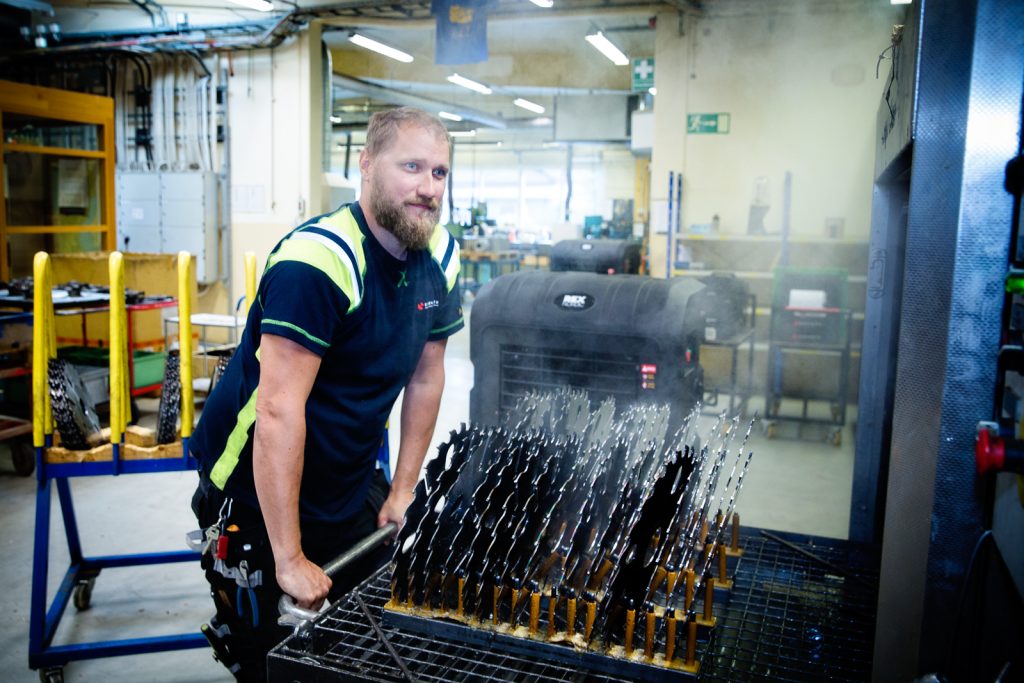
Instead of wasting energy by cooling unused areas, targeted cooling focuses on the specific areas that require cooling, making it a more efficient and cost-effective solution for businesses and industrial facilities. In this article, we delve into the benefits of targeted cooling, explaining why it is the best choice for professional use and large spaces, and how it can benefit your business financially, environmentally, and practically. Energy Savings and Efficiency For businesses, energy consumption is a significant expense, and cooling an entire space consumes considerably more energy than targeted cooling. Targeted cooling focuses on cooling only the areas where employees and equipment need it, such as workstations, meeting rooms, or specific production lines. Studies have shown that targeted cooling can reduce energy consumption by up to 30% compared to traditional whole-space cooling systems [MDPI] [MDPI]. This makes it a particularly attractive option for large spaces and businesses where energy costs can be significant. Rex Nordic’s mobile heat pumps and evaporative coolers are designed to maximize energy efficiency. They can quickly and effectively cool specific areas, making them the ideal choice for businesses that want to control energy costs without compromising comfort. Environmental Friendliness Businesses are increasingly aware of their environmental impact, and reducing energy consumption is a key part of sustainable business. Targeted cooling reduces energy consumption and thus the carbon footprint. This is particularly important for businesses aiming to meet environmental standards and improve their sustainability goals. A report by the US Department of Energy indicates that targeted cooling can significantly reduce carbon dioxide emissions, especially in large industrial facilities. Studies by the European Environment Agency (EEA) also highlight that targeted cooling is an effective way to meet growing cooling needs while supporting EU energy and climate goals [European Environment Agency’s home page]. Comfort and Flexibility Large spaces such as warehouses, production facilities, and office complexes benefit from the flexibility of targeted cooling. With targeted cooling, you can easily direct the cooling to areas where it is most needed, such as workstations where employees spend most of their time. Rex Nordic’s mobile heat pumps and evaporative coolers are user-friendly and require no installation. Additionally, these units are portable, allowing you to use them in different departments or work areas as needed. Cost-Effectiveness Whole-space cooling systems are generally expensive to install and maintain. Targeted cooling offers a cost-effective alternative. Lower costs and reduced energy consumption make it an economically sensible choice for businesses. Rex Nordic’s products offer excellent value for money. They are durable and long-lasting, meaning that the investment in these products pays off in the long term. Furthermore, their ease of use and low maintenance requirements keep operational costs low. Summary Targeted cooling offers several advantages over whole-space cooling, particularly for professional use and large spaces. It is energy-efficient, environmentally friendly, cost-effective, and improves comfort and employee health. Rex Nordic’s mobile heat pumps and evaporative coolers are excellent choices that meet these needs by providing efficient and economical cooling. Consider targeted cooling the next time you look for cooling solutions for your business – it is a wise choice for both your business and the environment.
Moisture and diesel infrared heaters
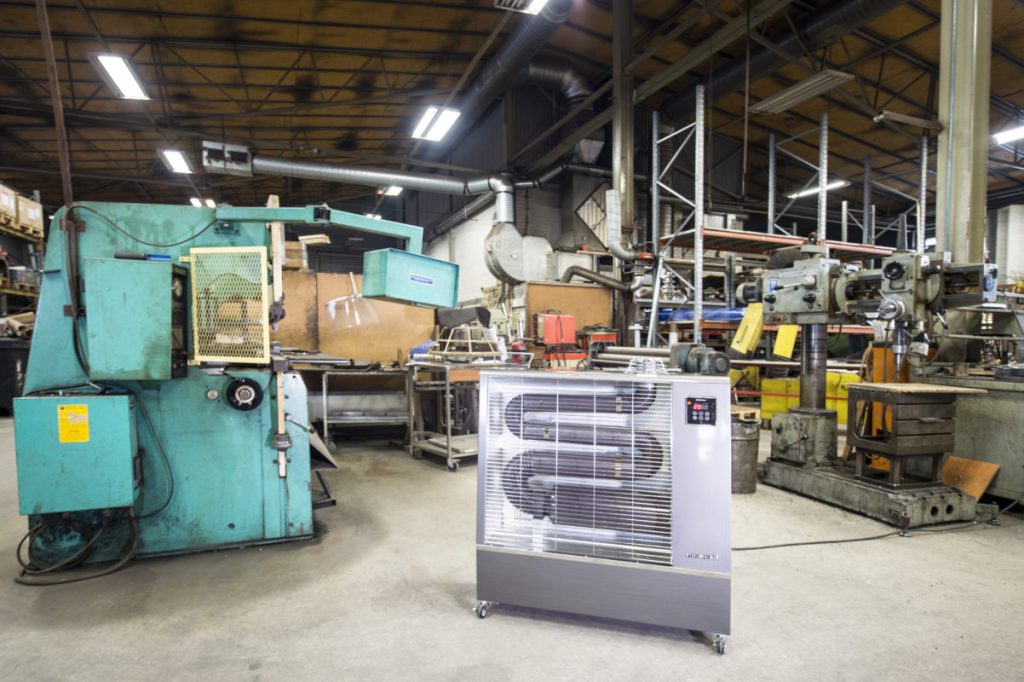
When heating cold spaces, the moisture tends to condensate on windows, metal structures or other structures in the heated space. From where does this moisture actually come? As a rule, air contains humidity in the form of water vapour: the hotter the air, the more humidity there is in it. Cold air cannot hold as much moisture as warm air. Air that contains water vapour heats up quicker than solid structures. Warmer air gathers more water vapour, but the solid structures in the heated space remain cool. The air close to the structures cools down, and the amount of water vapour in the air exceeds 100% RH. When the relative humidity of air exceeds 100%, water vapour in the air starts to condensate into droplets visible particularly on windows and metal surfaces in the heated space. You can also witness the same phenomena on a frosty pint of beer on a terrace in the summer. Two measurement units for humidity The amount of water vapour in the air, or humidity, is described by two different concepts. One expresses the amount of water in the water vapour found in a cubic metre of air. This is referred to as absolute humidity. The other, relative humidity, expresses the percentage of water vapour contained in the air. Relative humidity may vary from totally dry air (0%) to saturated air (100%) that contains the maximum amount of water vapour possible. Oil heaters produce carbon dioxide and water vapour Airrex infrared heaters burn diesel or fuel oil extremely efficiently, using almost 100% of the energy contained in the oil for the heating of the space. In practical terms, this means that all of the 10 kW of (heat) energy contained in a litre of fuel is utilised. 10-kW heating capacity is enough to significantly raise the indoor temperature in most heated spaces. Once the desired working temperature has been achieved, Airrex heater’s thermostat steps in to control the heater, reducing fuel consumption and emissions. A litre of fuel or diesel oil burnt creates 2.7 kg of carbon dioxide and 560 grams of water. Heating dries the air The capacity of air to hold water vapour is almost directly proportional to the temperature of the air. The colder the air, the smaller the amount of water vapour it can contain. This explains why heating is the most effective way to dry out spaces. Even then, formation or entry of humidity from outside the heated space must be prevented. If the relative humidity in a largish hall space is 40% at 0 degrees Celsius, each cubic metre of air in the space contains 1.9 grams of water vapour (water). If additional humidity is prevented from entering the space, raising the temperature in the space from zero to +20 degrees Celsius reduces relative humidity to five (5) per cent. It does not take much to heat air The average heat capacity of air is 1.01 kJ/kg/°C, based on which it is possible to calculate the output needed to heat it. To raise the temperature of one cubic metre of air by one degree, you need approximately 0.00035 kWh of heating power. If the heated space is, for example, 300 m3 in size, the power required to heat the air in it from zero degrees to +20 degrees is just 2.1 kWh. In reality, however, the above figure is not enough because of the significant effect the structures and objects in the heated space have on the required heating capacity, not to mention any heat loss due to structural leaks and ventilation in the space in question. Humidity created by an oil heater is not a risk The fact of the matter is as follows: to heat a 300-cubic-metre space from zero to +20 degrees, you require about 10 kWh of power, or one litre of oil, at maximum. This translates into 560 grams of water vapour that is mixed with 300 cubic metres of air. The amount of water in each cubic metre of air is, then, increased by about 1.9 grams. If the initial amount of water vapour per cubic metre of air in the heated space was 1.9 grams, the figure after the heating would be approximately 3.8 grams. At +20 degrees Celsius, this translates into about 30% relative humidity, which will not cause a moisture damage risk to any structure whatsoever. Unique benefits of oil-fired Airrex infrared heaters Radiation heaters do not heat the air as such, but the objects in the way of the infrared waves. Thus, the structures and objects in the heated space will become warm quicker than the air. This efficiently prevents condensation of humidity in the air on the surfaces, minimising the risk of damage due to moisture. Another factor that reduces the moisture risk is fuel. Many infrared heaters use liquefied petroleum gas, or LPG, which, when burnt, produces carbon dioxide and water. It is, therefore, a very clean fuel. Airrex heaters are in practice just as clean, but they produce considerably less water than LPG heaters. One (1) kg of LPG produces approx. 12.8 kWh of energy when burnt. At the same time, 2.99 kg of carbon dioxide and 1.63 kg (1,630 grams) of water vapour are produced. Using diesel oil, the amount of water vapour produced to achieve the equivalent heating power is approx. 720 grams – less than half of that with LPG. This is a significant difference, at least for anyone wishing to minimise the risk of moisture damage. Infrared heat dries out structures As described above, infrared heating increases the temperature of the structures and objects in the heated space rather than the air. This prevents condensation of moisture on the surfaces of the structures. Infrared heaters can also be used to remove humidity in applications such as the drying of moisture damage from concrete structures, for example. If there is moisture in the structures of the heated space from the time of construction or for some other reason, infrared heaters can be used
What makes infrared heaters better than fan heaters?
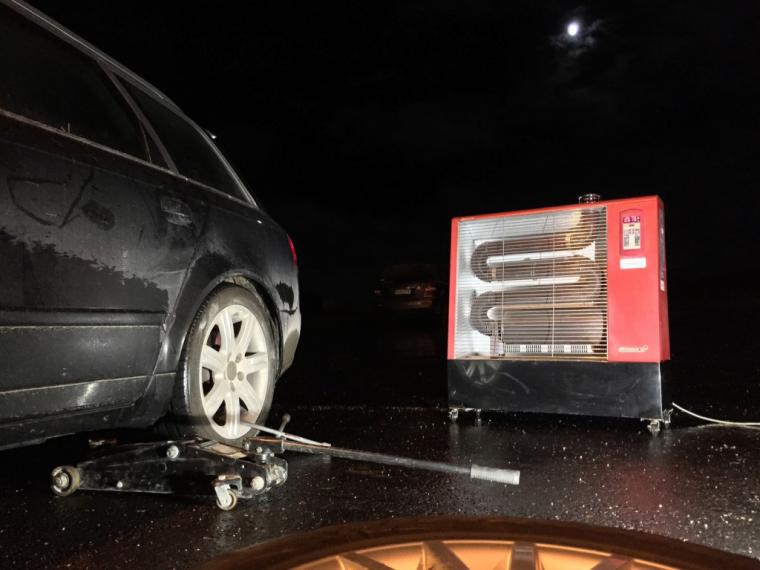
There are many significant differences between an infrared heater and a traditional fan heater. For instance, instead of blowing, infrared heaters radiate heat. Infrared radiation heats materials, not air. To learn more about infrared radiation, visit, for example, Wikipedia. You can feel the heating effect of an infrared heater even outdoors in windy weather because the heat will get through instead of being whisked away with the wind. The warm air blown from the fan heater will disappear in the wind right out of the heater. Airrex infrared heaters are an excellent choice for, for example, service tasks that have to be performed outdoors, e.g. changing a tyre of a car or repairing machinery (forest harvester, tractor, etc.) in field conditions.
Large space heaters and exhaust management
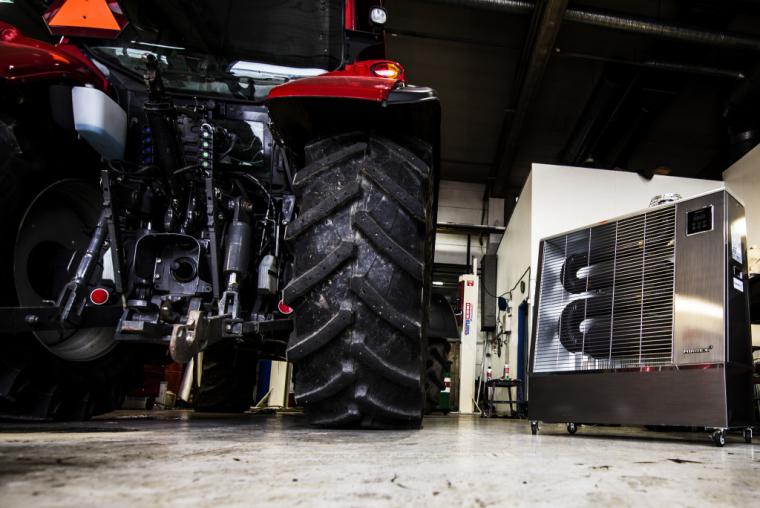
Not many enjoy the exhaust gases produced from burning diesel or fuel oil. A lot of people have found that the gases cause unpleasant symptoms in the respiratory system, mouth and throat, or even eyes, as the most sensitive people have reported.Exhaust management is not a problem for users of Airrex large space heaters that burn the fuel so efficiently that a separate exhaust outlet to the outside is not needed. If the combustion is incomplete, the exhaust will contain various harmful compounds. Unburnt hydrocarbons, carbon monoxide, various particulates, nitrous oxide and, of course, carbon dioxide. In case of high-quality hydrocarbon-based fuel, such as diesel, it is possible to achieve near-perfect combustion, meaning that the exhaust emissions consist mostly of carbon dioxide that is not dangerous as such, and water in the form of water vapour. Perfect combustion is the reason why Airrex infrared heaters do not require separate exhaust piping. Kymenlaakso University of Applied Sciences (KYAMK) is one of the few institutes in Finland that perform emission measurements. Marko Piispa, leader of the emission measurement unit, recalls that the emissions from the Airrex heaters were low. He does not comment on their safety when used in sealed spaces: this can be determined by studying the guidelines and limit values set out by the authorities. Airrex infrared heaters and exhaust gases According to the Decree of the Ministry of Social Affairs and Health on concentrations known to be harmful (HTP) and the Ministry of the Environment procedure on carbon dioxide levels in indoor air, the maximum allowed concentration of carbon dioxide during normal weather conditions and while the room is occupied is 1,200 ppm. The acceptable exposure limit at workplaces during an 8-hour workday is 5,000 ppm. Correspondingly, the amount of carbon monoxide in the air during an 8-hour workday should not continuously exceed 10 mg/m3. The limit for nitrogen dioxide concentration known to be harmful is 6 ppm, or 11 mg/m3, over 15 minutes of exposure. Operating at full capacity, Airrex AH-300 produces one milligram of carbon monoxide per cubic metre of air, meaning that the recommended limit value would not be reached during 10 hours of working. As heaters rarely operate at full capacity all the time, the maximum working time is much longer. And, if normal ventilation is ensured, carbon monoxide creates no risk whatsoever. Harmless as such, carbon dioxide is, in fact, very important for the human body. According to the emission report by KYAMK, exhaust gases from Airrex AH-300 contain 10% of carbon dioxide that is very quickly mixed with the air in the room space. This is why the carbon dioxide emissions are not considered significant. Nitrogen oxides created when burning diesel and fuel oil are considered hazardous to health. Noteworthy in the emission measurement report of an Airrex AH-300 operating at full capacity is that the nitrogen oxide emissions with biodiesel were 201 mg/m3 while those with regular diesel were 183 mg/m3. If exhaust gas is inhaled directly from the end of an AH-300 exhaust pipe, nitrogen oxides cause more stress on the body than recommended (6 ppm, or 11 mg/m3, 15 min of exposure), but the concentration decreases significantly when the exhaust gases mix with the air in the heated space. As regards an Airrex AH-300 operating at full capacity, the value will remain below the concentration known to be harmful (HTP) determined by the authorities when the volume of the heated space is approximately 200 cubic metres. This translates into a room that is approximately 8 x 10 x 2.5 metres in size. If the ventilation of the heated space is in line with the recommendations, i.e. a complete air change per every two hours, Airrex AH-300 can be used in spaces smaller than 100 cubic metres in size without risk of any health hazards due to nitrogen dioxide. With a capacity of 13–15 kW, Airrex AH-300 warms up such a small space very quickly, after which full capacity is no longer needed. This means less nitrogen oxide emissions and, subsequently, negligible health hazards thereof. Emissions in summary In summary, Airrex infrared heaters do not produce dangerous amounts of carbon monoxide – and no separate exhaust piping is required. The carbon dioxide that is created is no more a health hazard than carbon dioxide normally found in the air. During initial heating in a small space, the level of nitrogen oxides created may rise to concentrations determined hazardous by the authorities. The risk can be reduced by staying away from the (small) space during the initial heating and ensuring normal ventilation thereafter. The risk can be eliminated entirely by leading the exhaust gases outside the heated space. The smaller amount of nitrogen oxides created during the less capacity-intensive continuous heating keeps the level below the concentrations known to be hazardous. In a nutshell: a well-designed diesel heater can achieve such perfect combustion that there is no need for a separate exhaust pipe. After reviewing the calculations, this is also confirmed by Marko Piispa, who performed the emission measurements: “Emissions from the Airrex heater were quite low. They do not present a health risk in a large hall with appropriate ventilation.” Visit our webstore to read more about the safe and efficient Airrex heaters .
Considering a diesel heater? Tubular fan heater or a safe infrared heater?
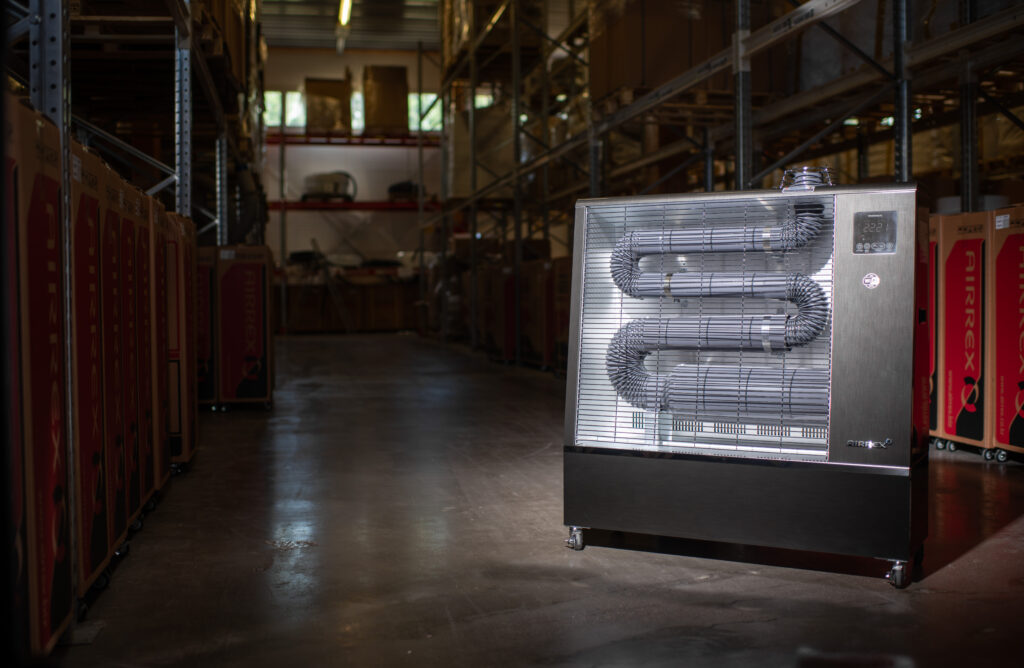
The energy contained in diesel or fuel oil can be used for heating by burning the oil. Simple traditional auxiliary heaters consist only of an oil burner and a fan that is used to direct the heat from the oil burner to the desired spot in the form of hot airflow. Airrex infrared heaters also include an oil burner, but instead of a naked flame, the heat is formed in a heat generator doubling as the exhaust system. From the heat generator, the heat is radiated to the surrounding atmosphere in the form of infrared waves. The heat radiation can be directed using the heat reflector structures in the heater. Single- or multi-stage combustion diesel heaters The forced airflow of traditional oil heaters with a burner and fan transfers all particles of the burned oil, including exhaust gases and unburned particles, directly through the heater into the heated space. Even with an efficient burner, the exhaust gas will contain small amounts of unburnt hydrocarbons and any contamination in the fuel. This will cause different kinds of smoke and odour emissions. Basic tubular heaters simply use the fan to circulate the air in the heated space pass the oil burner. This means that unburnt hydrocarbons from the oil burner “supplement” any impurities already in the heated space air. The amount of unburnt hydrocarbons increases significantly if the diesel or fuel oil does not burn efficiently. This is usually the case during the starting or stopping of the heater or if there is a problem with the fuel supply to the burner. Airrex infrared heaters burn the diesel or fuel oil very efficiently because, after the oil has been burned in the burner, practically all the remaining hydrocarbons are burned in the 3-stage exhaust system that doubles as the heat generator. In practice, the exhaust is left with only harmless carbon dioxide and water without any unburnt hydrocarbons causing unpleasant odours and/or health hazards. Airrex auxiliary heaters utilise practically all the energy contained in the fuel, meaning that they are highly efficient and consume very little fuel. Exposed or protected oil burner? Basic fan-equipped diesel and fuel oil heaters have their oil burners in direct contact with the outside air, exposing them to any impurities and humidity in the air. This can result in corrosion or dirt build-up in the burner structures, decreasing the performance and reliability of the burner. If you use a fan-equipped auxiliary heater with an oil burner as the heat source, you must always make sure that the air going inside the heater does not contain any combustible material, such as dust, straws of hay or any combustible material that can be carried by the airflow. Another thing to remember when using this kind of a heater is that you also must consider the fire hazard caused by the hot air coming from the heater and any smouldering particles carried in it. In Airrex infrared heaters, the oil burner is enclosed inside the device and has its own separate air intake channel. All air coming to the burner is burnt, and the resulting exhaust gases are directed to a long exhaust system that doubles as the heat generator. The flame of the burner is not in contact with the surrounding space, and exhaust gases and any sparks cool down and die out harmlessly in the exhaust system. The long exhaust system also protects the burner against damages due to any impurities and humidity in the air. Difference between heating by airflow and heating by radiation In case of a traditional oil burner, the hot naked flame heats the air directed past it by the fan. This means that the air in front of the auxiliary heater may be very hot. The heating effect becomes more even when the hot air mixes with ambient air. The heating effect of the heated air circulated by the fan can only be felt in places where the air can reach. In a large space with obstacles or structures blocking the airflow, there will be “nooks and crannies” where the heat cannot get. Heat energy radiated by an infrared heater does not heat the air but the objects with which it comes in contact. Therefore, you can be close to the heater without feeling uncomfortably hot. Heat radiation spreads evenly in the space, literally warming up the objects in its path from the inside out. Once the objects and structures in the heated space warm-up, they also warm up the space evenly. Do you want to circulate dust and air contaminants? Fan-boosted air circulation always circulates contaminants, dust and other impurities in the space as well. This spreads air contaminants everywhere, including people’s skin and lungs and from there further in the body. Heat radiation from an infrared heater does not cause any superfluous air movement that would cause dust or any contaminants in the heated space to migrate to the workspaces or supplies or in the bodies of people there. Humming fan and buzzing burner – or not? The humming sound of an efficient oil burner is familiar to all who have been around one. Traditional auxiliary heaters only have sound damping structures on the sides of the burner. And to ensure safe heater operation, the heated air must be made to move efficiently. This requires a fan that inevitably produces noise. Today, some high-end traditional auxiliary diesel heaters already have reasonably silent fans. In case of the fully enclosed Airrex infrared heaters, the air to the oil burner is conveyed via a separate sound dampening channel. The exhaust system located downstream the burner utilises any energy left from the burned oil and also dampens the “exhaust noise” down to a very moderate level. Airrex infrared heater’s noise level is 48 dB, corresponding with that of a quiet speaking voice. Burner requires electricity – a fan easily doubles the need for power Traditional auxiliary oil heaters have some components that require electric power: fuel pump, oil burner with the associated control electronics and the fan that
Fuel-fired large space heater – how much supply air is needed, and other questions.
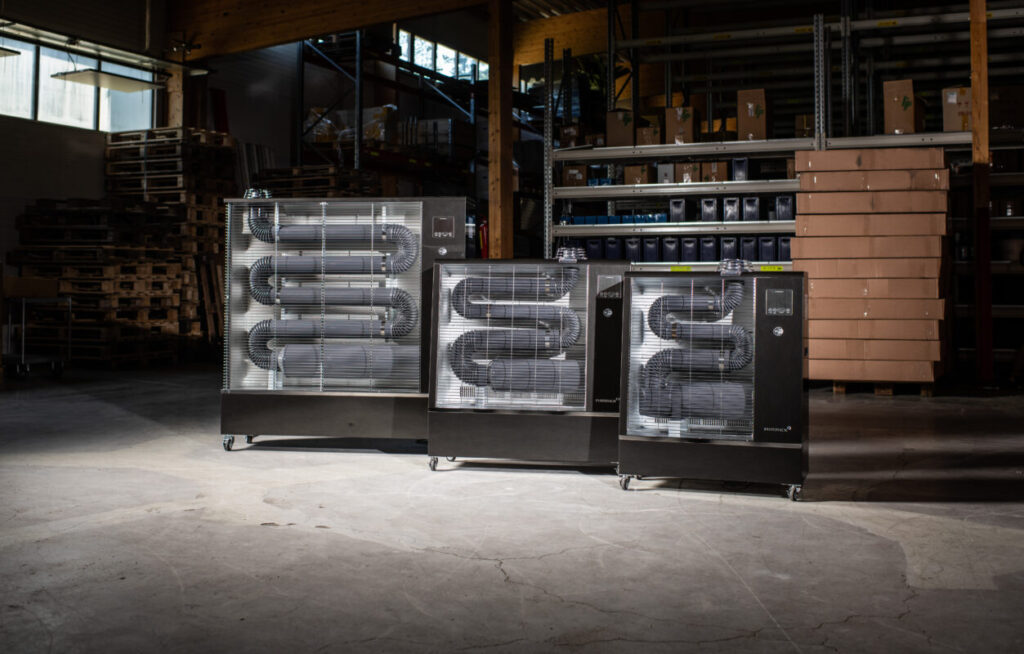
How is it possible to have a large space heater without an exhaust pipe? It is made possible by using pure high-quality fuel that ensures perfect combustion. Of the exhaust, more than 99% is carbon dioxide and water vapour that are parts of the air that we breathe. There is practically no soot or other fine particles, not even carbon monoxide. Exhaust from clean-burning high-quality fuel contains very low nitrogen oxide levels that do not constitute a health risk. To learn more, read this article. Water vapour is in no way hazardous to health, and the moisture in the exhaust gas of Airrex infrared heaters does not harm the structures of the heated space. Oil heater and carbon dioxide load There are two stages in warming up enclosed spaces, such as halls and warehouses: initial heating and continuous heating. During the initial heating, the fuel heater blows or radiates heat at maximum power, producing the maximum amount of exhaust gases. Once the space is heated, continuous heating only requires a fraction of the heater’s heating capacity. In this stage, Airrex infrared heaters typically use only a small amount of fuel per hour. Due to the two heating stages, the exhaust load in the heated space also varies greatly. Therefore, the ventilation performance required to ensure an appropriate amount of supply air and a level of carbon dioxide suitable for people to breathe varies. Load on full heating capacity Airrex infrared heaters are offered in three capacity classes. The heating capacity of the smallest Airrex AH-200 is 13 kWh, the heating capacity of the medium Airrex AH-300 is 15 kWh, and the capacity of the largest AH-800 is up to 22 kWh. The capacity is achieved by burning approximately 1.0–2.5 litres of fuel per hour. Burning 1.5 litres of fuel or diesel oil produces approximately four kilograms, or 4,000 grams, of carbon dioxide. The burning process requires approximately 22 cubic metres of air. Correspondingly, to burn 2.5 litres requires approximately 36 m3 of air and produces approximately 6,600 grams of carbon dioxide as a combustion product. The carbon dioxide produced by the heating makes working in the heated space more stressing. But when does it become a health risk? Carbon dioxide is not dangerous as such, but large concentrations are considered harmful Carbon dioxide is one of the normal gases in the air and, as such, not dangerous at all. On the contrary, the human body needs carbon dioxide to work. If the level of carbon dioxide in the air increases, we feel like we are “running out of breath” and the body reacts by automatically increasing the rate of breathing. A high level of carbon dioxide in the air is reported to cause headache, fatigue and a feeling of stuffy air. The amount of carbon dioxide in the air is expressed in ppm, or parts per million. The amount of carbon dioxide in the open air is approximately 380 ppm. According to the Decree of the Ministry of Social Affairs and Health on concentrations known to be harmful (HTP) and the Ministry of the Environment procedure on carbon dioxide levels in indoor air, the maximum allowed concentration of carbon dioxide during normal weather conditions and while the room is occupied is 1,200 ppm. The acceptable exposure limit at workplaces during an 8-hour workday is 5,000 ppm. This translates into carbon dioxide concentrations of half a per cent (0.5%) mixed in the air. Something about the level of stress caused by carbon dioxide on the human body can be deduced from the fact that submarine crews work and live in an atmosphere that contains approximately one per cent (10,000 ppm) of carbon dioxide. Even a concentration of 2%, or 20,000 ppm, has not been found to cause adverse health effects during short-term exposure. How much does an auxiliary oil heater increase the carbon dioxide concentration in a hall space? The specific weight of air varies according to the temperature and humidity of the air, the average used in these calculations being 1.225 kg/cubic metre (at sea level). Of this figure, the amount of carbon dioxide is 0.038% = 0.0004655 kg, or approximately 0.47 grams. The 5,000 ppm carbon dioxide exposure limit allowed at workplaces translates into approximately 6.125 grams of carbon dioxide per cubic metre of air. Considering the amount of carbon dioxide already in the air (0.47 grams/m3), the amount of extra carbon dioxide allowed to be mixed in the air is 5.655 grams. If we now presume that there is no ventilation whatsoever in a heated space with Airrex AH-300 infrared heater blasting away at full capacity, how big must the space be in order to avoid any health hazard due to the exhaust? The four kilos, or 4,000 grams, of carbon dioxide produced per hour requires a space of approximately 710 m3to dilute below the 5,000 ppm concentration level. The area of a hall space that is four (4) metres high should, then, be approximately 180 square metres. Using the more powerful Airrex AH-800 for an hour at full capacity would require a hall space of approximately 1,150 cubic metres to keep the increase in the carbon dioxide level below the recommended 5,000 ppm limit. Continuous heating requires only one-third or significantly less fuel compared to full capacity heating. This means that carbon dioxide emissions are only one-third or less by comparison. Subsequently, the volume of the heated space only needs to be 230–380 m3 to keep the carbon dioxide level below the recommended workplace exposure limit. The floor area of a 2.70-metre high hall space with a volume of 230–380 m3 is 85–140 square metres. The significance of ventilation The above examples are theoretical in nature because there are not that many heated spaces that are completely sealed. On the other hand, a combination of a particularly low ventilation setting and use of a fuel-fired heater will result in continuously increasing indoor air carbon dioxide levels, something that should be considered. If the heated space is ventilated in a normal manner in compliance with the regulations, meaning a
